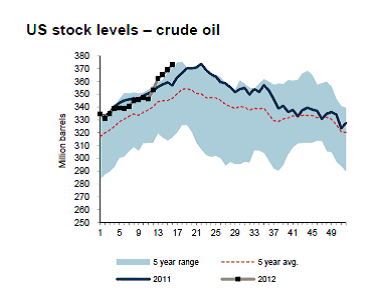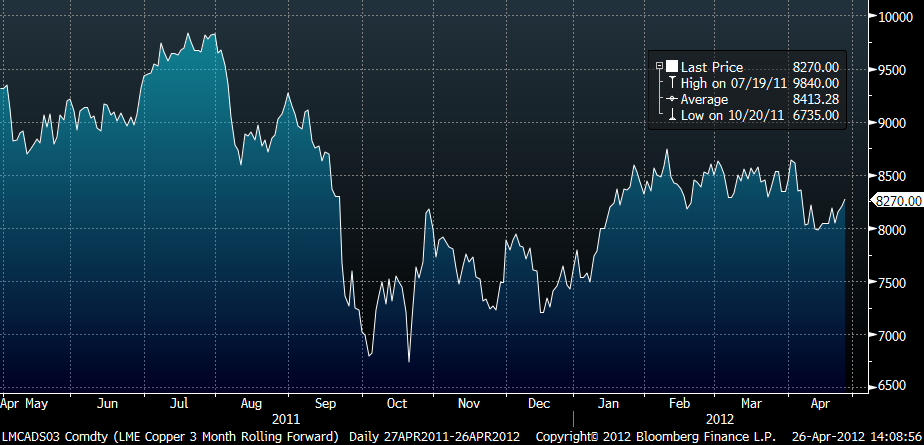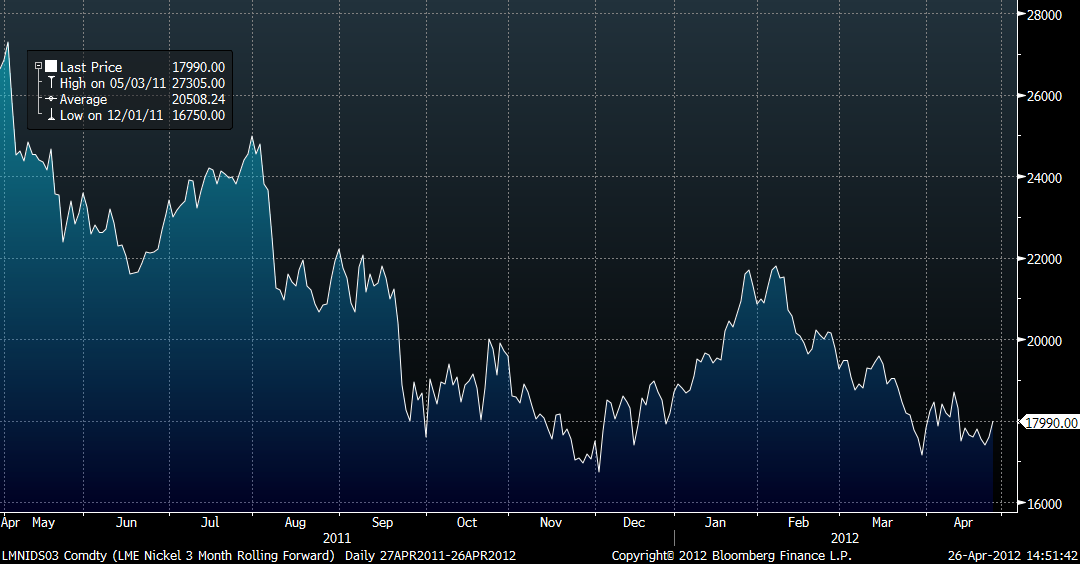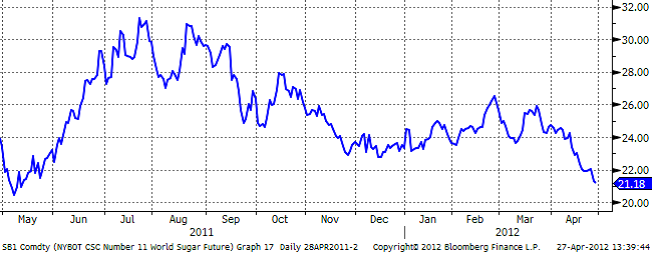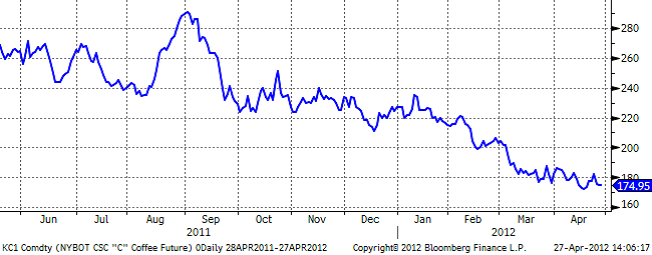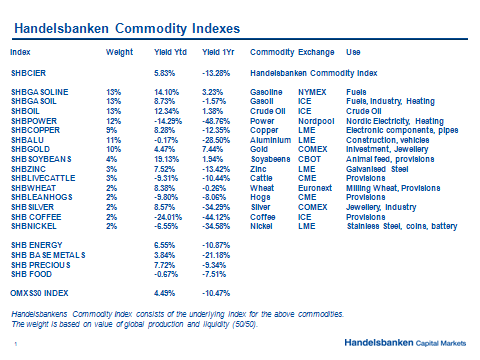Analys
SHB Råvarubrevet 27 april 2012
 Råvaror Allmänt
Råvaror Allmänt
Våra vyer:
- Energi: Neutral
- Basmetaller: Neutral
- Ädelmetaller: Neutral
- Livsmedel: Neutral
Marknaden har sedan förra veckobrevet fortsatt att präglas av svagare riskaptit. Europeiska börser har fallit cirka fem procent och krediter har surnat. Europabaisse och sämre makrostatistik har präglat Europa medan amerikanerna har fokuserat på den förvånansvärt starka rapportsäsongen.
I Europa är utvecklingen fortsatt svagare än väntat. Nu senast pekar det sammanvägda inköpschefsindexet på att BNP började krympa igen i början av det andra kvartalet. I detta makroklimat blir det svårt för de flesta länder att möta sina budgetmål. Obligationsmarknaden uttrycker återigen stress efter att LTRO effekten nu är över. Den politiska agendan innehåller många orosmoln och marknaden befarar sannolikt ett politiskt vakuum.
ECB:s Draghi mjuknade något under veckan. I sitt tal till Europaparlamentet hänvisade han inte längre till ekonomins gradvisa återhämtning utan valde istället att betona valutaunionens svåra utmaningar. Bland annat sade han att likviditetsinjektionerna (LTRO) inte gett lika positiva ekonomiska effekter som ECB hoppats och att det är först nu som den finanspolitiska åtstramningen till fullo gör sig känd.
Vi har länge varit oroliga för Europa men påtalar att vi inte tror att krisen kommer att påverka den globala konjunkturen i större utsträckning.
Energi (neutral)
Elmarknaden
Elmarknaden steg något mot slutet av veckan efter att våta och milda prognoser slagit om till temperaturer under normalt för perioden och något torrare än tidigare vilket framför allt stärkt den korta kurvan. Tredje kvartalet handlas i skrivande stund kring 32 euro (en ökning om ca 2 procent över veckan) vilket är en bra bit under marginalkostnaden för kolgenererad kraft (marginalkostnad för kol sätter ofta priset på nordisk kraft under ett normalår, det vill säga normal hydrologi) som ligger kring 41.25 EUR/MWh. Marknaden har sannolikt diskonterat den goda energibalansen och räknat med väldigt låga priser på el under sommaren. Spotpriset för april har hittills blivit 32.30 euro vilket är 5.5 euro högre än den nivå där aprilkontraktet stängde i mars. Detta har sannolikt genererat en del köpintressen för det tredje kvartalet. Vi ser ut att få strax under 4 TWh nederbörd under kommande 10-dagarna vilket skulle innebära att energibalansen i Sverige + Norge kommer att vara ca +10.5TWh efter vecka 18. Med denna prognos räknar vi med att marknaden handlas oförändrat de kommande dagarna. Inte heller energikol eller utsläppsrätterna ger någon tydlig riktning.
Olja
Oljepriset har fluktuerat en hel del under veckan. På onsdagen föll priset på Brent som lägst till 117,45 USD/fat efter rykten om att Iran kan komma att kompromissa med sitt kärnvapenprogram för att undgå sanktioner från EU. Även stigande lager på olja satta press på priset. Amerikanska lagersiffror från Department of Energy visade råoljelager som steg mer än väntat, 3,9 miljoner fat mot väntade 2,8 miljoner fat. I skrivande stund handlas Brent-oljan på 119,73 USD/fat vilket är cirka 1 USD högre än veckans öppning.
Basmetaller (neutral)
Koppar
Koppar har gått upp 2,59 % under veckan och vi kan summera uppgången under året till 10,62 %. Det som drivit uppgången under veckan är rapporter om att Kina ska dra ned produktionen med 700 000 ton på årsbasis. Priset fann också stöd från Federal Reserve som upprepade att de skulle understödja tillväxten om det behövdes. Intressant i sammanhanget är att det förekommit rykten kring världens största kopparproducent, Codelco. Ryktet gör gällande att Codelco fått köpa in koppar på marknaden för att kunna fullfölja sina leveranskontrakt. Anledningen skulle vara produktionsproblem i deras chilenska gruvor. Trots alla dessa faktorer som talar för en stark kopparmarknad, så är vi neutrala till koppar och basmetaller. Den makroekonomiska utvecklingen är fortfarande svårtydd, med ett flertal utestående frågetecken.
Nickel
Nickel har gått upp 2,72 % under veckan och vi kan summera året till -2,24 %. Ett flertal rapporter under veckan har belyst vilka råvaror som kommer efterfrågas i det framtida Kinas konsumtionsstyrda ekonomi. De råvaror som borde gynnas är aluminium, nickel, palladium och guld. De metaller som missgynnas i en icke-investeringsstyrd ekonomi är stål, koppar och zink. Nickel skulle gynnas eftersom en konsumtionsstyrd ekonomi använder en högre andel rostfritt stål, där nickel är en viktig komponent. Efterfrågan på aluminium skulle öka eftersom Kinas nya elnät skulle baseras på aluminium och inte koppar. Palladium används i bilars katalysatorer och med en ökad miljömedvetenhet i Kina kommer efterfrågan att gå upp. Vår vy på nickel och basmetaller är fortfarande neutral, då vi anser att ovanstående faktorer är av långsiktig natur och kommer inte påverka priset i närtid.
Livsmedel (neutral)
Vete
Vetet i Chicago har gått upp något i pris under veckan, + ca. 0,8 procent, medan vetet i Paris är ned drygt 1,8 procent. Det amerikanska vetet har fått lite torrare och varmare väder under veckan, i nästa vecka väntas återigen lite nederbörd vilket kommer gynna grödan. I Europa är situationen ungefär som den var förra veckan, ganska blött och kallt generellt sett men lite torrt i väst och lite blött i öst. I Ryssland och Ukraina önskas mer regn, men än så länge finns det inga större skäl till oro. Skicket på det amerikanska höstvetet är i stort sett oförändrat sedan förra veckan – d.v.s. väldigt bra! 42 procent av höstvetet har nu gått i ax, att jämföra med snittet för de senaste fem åren om 15 procent. Minst lika väl står det till med vårvetet i USA, sådden bedöms vara avklarad till hela 57 procent, långt mer än genomsnittet för de senaste fem åren om 19 procent. Av vårvetet har dessutom 18 procent nått uppkomststadiet, vid samma tidpunkt var siffran 2 procent.
Majs
Majsen i Chicago noteras upp något sedan förra veckan, + ca. 0,4 procent. Lite regn under veckan har saktat ned arbetet med sådden något, men nederbörden gynnar samtidigt redan sådd majs. I nästa vecka väntas återigen lite torrare väder och sådden bör kunna fortgå i bra takt. I söndags uppgavs 28 procent av den amerikanska majsen vara sådd, inte längre rekordsnabbt men fortfarande klart större andel avklarad än genomsnittet för de senaste fem åren om 15 procent. Från Argentina rapporteras om växlande väderlek men inga större problem för pågående sådd.
Sojabönor
Sojabönorna i Chicago fortsätter uppåt i pris och noteras upp ca. 1,8 procent sedan fredagens stängning. Sojapriset är nu uppe på nivåer vi inte sett sedan mitten av år 2008 och för tillfället är det svårt att se några skäl till att priserna ska vända nedåt. Fortfarande är den allmänna uppfattningen att USDA ännu överskattar den sydamerikanska skörden och framtida nedjusteringar väntas, vilket ger viss osäkerhet och stöd till priserna. Starkt stöd under veckan har kommit även från fortsatt stark efterfrågan, främst från Kina som fortsätter köpa amerikansk soja av både gammal och ny skörd.
Softs
Socker
Priset på socker har sedan årets början sjunkit 2,3 % i London och 6,6 % i New York. Förra veckan såg vi en tillfällig prisuppgång baserat på vad som verkar vara handel inför Ramadan. Egypten har köpt 50,000 ton och Tunisien 54,000 ton inför Ramadan som börjar i juli. Det fortsatta stora utbudet på marknaden fortsätter att hålla sockret på låga nivåer. Estimatet på Brasiliens 2012/13 skörd är upp ca 1,6 M ton. Indien verkar genomgå en normal monsunperiod och kan därmed komma att undvika torka. I och med detta finns det inte längre någon större oro för tillgången av socker på marknaden vilket även det bidragit till prisnedgången i veckan. Sockret är för tillfället nere på elva månaders lägsta.
Kaffe
Priset på kaffe föll i veckan till ett månadslägsta till följd av att man påbörjat Arabicaskörden i delar av Brazilien (områdena Rondonia och Espirito Santo) samt p.g.a. att skörden förväntas bli ca 1,8 % större än tidigare estimat. I veckan publicerades siffror från USA, världens största kaffe konsument, som visar på 3% högre kaffekonsumtion jämfört med året innan. Antalet konsumerade koppar var 88,7 miljarder med ett värde på ca 56,95 miljarder US$.
Handelsbankens Råvaruindex
[box]SHB Råvarubrevet är producerat av Handelsbanken och publiceras i samarbete och med tillstånd på Råvarumarknaden.se[/box]
Ansvarsbegränsning
Detta material är producerat av Svenska Handelsbanken AB (publ) i fortsättningen kallad Handelsbanken. De som arbetar med innehållet är inte analytiker och materialet är inte oberoende investeringsanalys. Innehållet är uteslutande avsett för kunder i Sverige. Syftet är att ge en allmän information till Handelsbankens kunder och utgör inte ett personligt investeringsråd eller en personlig rekommendation. Informationen ska inte ensamt utgöra underlag för investeringsbeslut. Kunder bör inhämta råd från sina rådgivare och basera sina investeringsbeslut utifrån egen erfarenhet.
Informationen i materialet kan ändras och också avvika från de åsikter som uttrycks i oberoende investeringsanalyser från Handelsbanken. Informationen grundar sig på allmänt tillgänglig information och är hämtad från källor som bedöms som tillförlitliga, men riktigheten kan inte garanteras och informationen kan vara ofullständig eller nedkortad. Ingen del av förslaget får reproduceras eller distribueras till någon annan person utan att Handelsbanken dessförinnan lämnat sitt skriftliga medgivande. Handelsbanken ansvarar inte för att materialet används på ett sätt som strider mot förbudet mot vidarebefordran eller offentliggörs i strid med bankens regler.
Analys
Sell the rally. Trump has become predictable in his unpredictability

Hesitant today. Brent jumped to an intraday high of $66.36/b yesterday after having touched an intraday low of $60.07/b on Monday as Indian and Chinese buyers cancelled some Russian oil purchases and instead redirected their purchases towards the Middle East due to the news US sanctions. Brent is falling back 0.4% this morning to $65.8/b.

It’s our strong view that the only sensible thing is to sell this rally. In all Trump’s unpredictability he has become increasingly predictable. Again and again he has rumbled about how he is going to be tough on Putin. Punish Putin if he won’t agree to peace in Ukraine. Recent rumbling was about the Tomahawk rockets which Trump threatened on 10 October and 12 October to sell/send to Ukraine. Then on 17 October he said that ”the U.S. didn’t want to give away weapons (Tomahawks) it needs”.
All of Trump’s threats towards Putin have been hot air. So far Trump’s threats have been all hot air and threats which later have evaporated after ”great talks with Putin”. After all these repetitions it is very hard to believe that this time will be any different. The new sanctions won’t take effect before 21. November. Trump has already said that: ”he was hoping that these new sanctions would be very short-lived in any case”. Come 21. November these new sanctions will either evaporate like all the other threats Trump has thrown at Putin before fading them. Or the sanctions will be postponed by another 4 weeks or 8 weeks with the appearance that Trump is even more angry with Putin. But so far Trump has done nothing that hurt Putin/Russia. We can’t imagine that this will be different. The only way forward in our view for a propre lasting peace in Ukraine is to turn Ukraine into defensive porcupine equipped with a stinging tail if need be.
China will likely stand up to Trump if new sanctions really materialize on 21 Nov. Just one country has really stood up to Trump in his tariff trade war this year: China. China has come of age and strength. I will no longer be bullied. Trump upped tariffs. China responded in kind. Trump cut China off from high-end computer chips. China put on the breaks on rare earth metals. China won’t be bullied any more and it has the power to stand up. Some Chinese state-owned companies like Sinopec have cancelled some of their Russian purchases. But China’s Foreign Ministry spokesperson Guo Jiakun has stated that China “oppose unilateral sanctions which lack a basis in international law and authorization of the UN Security Council”. Thus no one, not even the US shall unilaterally dictate China from whom they can buy oil or not. This is yet another opportunity for China to show its new strength and stand up to Trump in a show of force. Exactly how China choses to play this remains to be seen. But China won’t be bullied by over something as important as its oil purchases. So best guess here is that China will defy Trump on this. But probably China won’t need to make a bid deal over this. Firstly because these new sanctions will either evaporate as all the other threats or be postponed once we get to 21 November. Secondly because the sanctions are explicit towards US persons and companies but only ”may” be enforced versus non-US entities.
Sanctions is not a reduction in global supply of oil. Just some added layer of friction. Anyhow, the new sanctions won’t reduce the supply of Russian crude oil to the market. It will only increase the friction in the market with yet more need for the shadow fleet and ship to ship transfer of Russian oil to dodge the sanctions. If they materialize at all.
The jump in crude oil prices is probably due to redirections of crude purchases to the Mid-East and not because all speculators are now turned bullish. Has oil rallied because all speculators now suddenly have turned bullish? We don’t think so. Brent crude has probably jumped because some Indian and Chinese oil purchasers of have redirected their purchases from Russia towards the Mid-East just in case the sanctions really materializes on 21 November.
Analys
Brent crude set to dip its feet into the high $50ies/b this week

Parts of the Brent crude curve dipping into the high $50ies/b. Brent crude fell 2.3% over the week to Friday. It closed the week at $61.29/b, a slight gain on the day, but also traded to a low of $60.14/b that same day and just barely avoided trading into the $50ies/b. This morning it is risk-on in equities which seems to help industrial metals a little higher. But no such luck for oil. It is down 0.8% at $60.8/b. This week looks set for Brent crude to dip its feet in the $50ies/b. The Brent 3mth contract actually traded into the high $50ies/b on Friday.

The front-end backwardation has been on a weakening foot and is now about to fully disappear. The lowest point of the crude oil curve has also moved steadily lower and lower and its discount to the 5yr contract is now $6.8/b. A solid contango. The Brent 3mth contract did actually dip into the $50ies/b intraday on Friday when it traded to a low point of $59.93/b.
More weakness to come as lots of oil at sea comes to ports. Mid-East OPEC countries have boosted exports along with lower post summer consumption and higher production. The result is highly visibly in oil at sea which increased by 17 mb to 1,311 mb over the week to Sunday. Up 185 mb since mid-August. On its way to discharge at a port somewhere over the coming month or two.
Don’t forget that the oil market path ahead is all down to OPEC+. Remember that what is playing out in the oil market now is all by design by OPEC+. The group has decided that the unwind of the voluntary cuts is what it wants to do. In a combination of meeting demand from consumers as well as taking back market share. But we need to remember that how this plays out going forward is all at the mercy of what OPEC+ decides to do. It will halt the unwinding at some point. It will revert to cuts instead of unwind at some point.
A few months with Brent at $55/b and 40-50 US shale oil rigs kicked out may be what is needed. We think OPEC+ needs to see the exit of another 40-50 drilling rigs in the US shale oil patches to set US shale oil production on a path to of a 1 mb/d year on year decline Dec-25 to Dec-26. We are not there yet. But a 2-3 months period with Brent crude averaging $55/b would probably do it.
Oil on water increased 17 mb over the week to Sunday while oil in transit increased by 23 mb. So less oil was standing still. More was moving.

Crude oil floating storage (stationary more than 7 days). Down 11 mb over week to Sunday

The lowest point of the Brent crude oil curve versus the 5yr contract. Weakest so far this year.

Crude oil 1mth to 3mth time-spreads. Dubai held out strongly through summer, but then that center of strength fell apart in late September and has been leading weakness in crude curves lower since then.

Analys
Crude oil soon coming to a port near you

Rebounding along with most markets. But concerns over solidity of Gaza peace may also contribute. Brent crude fell 0.8% yesterday to $61.91/b and its lowest close since May this year. This morning it is bouncing up 0.9% to $62.5/b along with a softer USD amid positive sentiment with both equities and industrial metals moving higher. Concerns that the peace in Gaza may be less solid than what one might hope for also yields some support to Brent. Bets on tech stocks are rebounding, defying fears of trade war. Money moving back into markets. Gold continues upwards its strong trend and a softer dollar helps it higher today as well.

US crude & products probably rose 5.6 mb last week (API) versus a normal seasonal decline of 2.4 mb. The US API last night partial and thus indicative data for US oil inventories. Their data indicates that US crude stocks rose 7.4 mb last week, gasoline stocks rose 3.0 mb while Distillate stocks fell 4.8 mb. Altogether an increase in commercial crude and product stocks of 5.6 mb. Commercial US crude and product stocks normally decline by 2.4 mb this time of year. So seasonally adjusted the US inventories rose 8 mb last week according to the indicative numbers by the API. That is a lot. Also, the counter seasonal trend of rising stocks versus normally declining stocks this time of year looks on a solid pace of continuation. If the API is correct then total US crude and product stocks would stand 41 mb higher than one year ago and 6 mb higher than the 2015-19 average. And if we combine this with our knowledge of a sharp increase in production and exports by OPEC(+) and a large increase in oil at sea, then the current trend in US oil inventories looks set to continue. So higher stocks and lower crude oil prices until OPEC(+) switch to cuts. Actual US oil inventory data today at 18:00 CET.
US commercial crude and product stocks rising to 1293 mb in week 41 if last nights indicative numbers from API are correct.

Crude oil soon coming to a port near you. OPEC has lifted production sharply higher this autumn. At the same time demand for oil in the Middle-East has fallen as we have moved out of summer heat and crude oil burn for power for air-conditioning. The Middle-East oil producers have thus been able to lift exports higher on both accounts. Crude oil and condensates on water has shot up by 177 mb since mid-August. This oil is now on its way to ports around the world. And when they arrive, it will likely help to lift stocks onshore higher. That is probably when we will lose the last bit of front-end backwardation the the crude oil curves. That will help to drive the front-month Brent crude oil price down to the $60/b line and revisit the high $50ies/b. Then the eyes will be all back on OPEC+ when they meet in early November and then again in early December.
Crude oil and condensates at sea have moved straight up by 177 mb since mid-August as OPEC(+) has produced more, consumed less and exported more.

-

 Nyheter4 veckor sedan
Nyheter4 veckor sedanOPEC+ missar produktionsmål, stöder oljepriserna
-

 Nyheter2 veckor sedan
Nyheter2 veckor sedanGoldman Sachs höjer prognosen för guld, tror priset når 4900 USD
-

 Nyheter3 veckor sedan
Nyheter3 veckor sedanBlykalla och amerikanska Oklo inleder ett samarbete
-

 Nyheter3 veckor sedan
Nyheter3 veckor sedanGuld nära 4000 USD och silver 50 USD, därför kan de fortsätta stiga
-

 Nyheter2 veckor sedan
Nyheter2 veckor sedanLeading Edge Materials är på rätt plats i rätt tid
-

 Nyheter2 veckor sedan
Nyheter2 veckor sedanNytt prisrekord, guld stiger över 4000 USD
-

 Nyheter3 veckor sedan
Nyheter3 veckor sedanEtt samtal om guld, olja, koppar och stål
-

 Analys3 veckor sedan
Analys3 veckor sedanOPEC+ will likely unwind 500 kb/d of voluntary quotas in October. But a full unwind of 1.5 mb/d in one go could be in the cards


